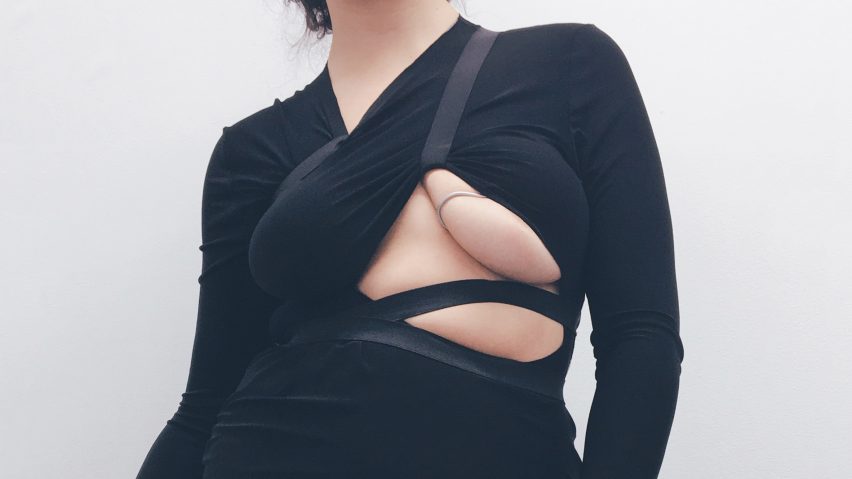This collection of cloth and metal-wire garments by Brazilian fashion designer Karoline Vitto finds beauty in the bulges of flesh that women are encouraged to cover up.
Designed as part of her masters degree at London's Royal College of Art, Vitto's The Body as Material collection features seven garments that accentuate the rolls and curves of the female form in different ways.
The graduate told Dezeen how the project came from "a very personal place", inspired by her own relationship with her body over the years.
Having grown up in Brazil, Vitto explained how she was surrounded by culturally rooted beauty standards that encouraged plastic surgery and unhealthy diets.
It was only once she moved to the UK that Vitto started having a better relationship with her own body.
"The project started by me looking at how I had dealt with my own body image over the previous years," Vitto explained. "I started by taking a series of photographs wearing a waist clincher I had bought in Brazil a couple of years ago."
"The intention of that purchase was having a slimmer figure, but the piece was so tight that it would make rolls pop up and down," she continued. "So, to smooth them out, you'd need a specific type of bra, then a specific type of knickers and so on."
"I was interested in proposing a new way of looking at those areas that I had tried to hide so much before."
The fashion collection includes seven pieces, from trousers and skirts to waspies – a type of corset – and maxi-dresses.
According to the designer, each garment acts as a representation of an area she used to be self-conscious about.
"To me, this collection is not really about size, but about form," Vitto explained. "Aesthetic pressure is something that most women, if not all women, suffer from."
"I'm not trying to say that this is a solution, or that I am telling everyone's story – body acceptance is a very individual process – but what I really hoped with this collection was proposing a kinder way of looking at areas we used to consider 'flaws'."
The designer's favourite piece is a body-contouring midi dress made from different types of heavy-weight black jersey, with one long sleeve arm and one sleeveless arm.
The dress boasts an under-boob cut-out and a large, curvy mesh panel running down the centre of the garment that subtly reveals the wearer's skin underneath.
It also features an oblong-shaped brass element used to amplify back rolls.
Another piece is a pair of black cotton satin-flare trousers that are shaped by seams and darts on the bum, which feature a high waist on the back and a low waist at the front.
An accompanying elastic belt twists twice around the body to create different pressure points.
Vitto also designed a structured, strapped waspie as a reinterpretation of the waist clincher. The piece sits snug below the breasts and extends to the bottom of the waist, featuring cut-outs on each side, and elastic strips that pinch the skin in different places.
Also included in the collection is a structured asymmetric top with cut-outs on the waist, which has a wide strap on one shoulder and is strapless on the other. A thick elastic band stretches across one of the breasts in place of a bar cup.
Other pieces in the collection include an extra-short skirt shaped to the bum, a contouring midi dress with a large under-boob cut-out, and a maxi-dress with curved seams that follow shadows caused by the body.
Many brands are making moves towards becoming more body positive. Nike recently overhauled the women's floor of its flagship store in London to include mannequins with different body types, including plus size and para-sport.
"I think more and more brands are concerned about representativity," Vitto told Dezeen. "That means not only more diversity on catwalks but also more sizes to chose from – different body types on ads and media."
"However, I know that there has been a lot of talk about how body positivity is a 'trend', which is a word that I totally disagree with," she continued. "It shouldn’t be a trend, it should be part of what we consider when we design."
"Ultimately, that's one of the biggest barriers for small brands and young designers, the variety of sizes always makes production more complicated."
"I would still love to see not only more sizes, but also more shapes within the same size," she added.

